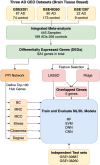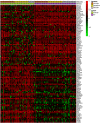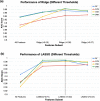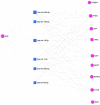Exploiting machine learning models to identify novel Alzheimer's disease biomarkers and potential targets
- PMID: 36973386
- PMCID: PMC10043000
- DOI: 10.1038/s41598-023-30904-5
Exploiting machine learning models to identify novel Alzheimer's disease biomarkers and potential targets
Abstract
We still do not have an effective treatment for Alzheimer's disease (AD) despite it being the most common cause of dementia and impaired cognitive function. Thus, research endeavors are directed toward identifying AD biomarkers and targets. In this regard, we designed a computational method that exploits multiple hub gene ranking methods and feature selection methods with machine learning and deep learning to identify biomarkers and targets. First, we used three AD gene expression datasets to identify 1/ hub genes based on six ranking algorithms (Degree, Maximum Neighborhood Component (MNC), Maximal Clique Centrality (MCC), Betweenness Centrality (BC), Closeness Centrality, and Stress Centrality), 2/ gene subsets based on two feature selection methods (LASSO and Ridge). Then, we developed machine learning and deep learning models to determine the gene subset that best distinguishes AD samples from the healthy controls. This work shows that feature selection methods achieve better prediction performances than the hub gene sets. Beyond this, the five genes identified by both feature selection methods (LASSO and Ridge algorithms) achieved an AUC = 0.979. We further show that 70% of the upregulated hub genes (among the 28 overlapping hub genes) are AD targets based on a literature review and six miRNA (hsa-mir-16-5p, hsa-mir-34a-5p, hsa-mir-1-3p, hsa-mir-26a-5p, hsa-mir-93-5p, hsa-mir-155-5p) and one transcription factor, JUN, are associated with the upregulated hub genes. Furthermore, since 2020, four of the six microRNA were also shown to be potential AD targets. To our knowledge, this is the first work showing that such a small number of genes can distinguish AD samples from healthy controls with high accuracy and that overlapping upregulated hub genes can narrow the search space for potential novel targets.
© 2023. The Author(s).
Conflict of interest statement
The authors declare no competing interests.
Figures






Similar articles
-
Type 2 Diabetes Mellitus and its comorbidity, Alzheimer's disease: Identifying critical microRNA using machine learning.Front Endocrinol (Lausanne). 2023 Jan 19;13:1084656. doi: 10.3389/fendo.2022.1084656. eCollection 2022. Front Endocrinol (Lausanne). 2023. PMID: 36743910 Free PMC article.
-
miR-129-5p as a biomarker for pathology and cognitive decline in Alzheimer's disease.Alzheimers Res Ther. 2024 Jan 9;16(1):5. doi: 10.1186/s13195-023-01366-8. Alzheimers Res Ther. 2024. PMID: 38195609 Free PMC article.
-
Identifying Hub Genes and miRNAs Associated with Alzheimer's Disease: A Bioinformatics Pathway to Novel Therapeutic Strategies.Biomolecules. 2024 Dec 20;14(12):1641. doi: 10.3390/biom14121641. Biomolecules. 2024. PMID: 39766348 Free PMC article.
-
A Systematic Review of MicroRNA Expression as Biomarker of Late-Onset Alzheimer's Disease.Mol Neurobiol. 2019 Dec;56(12):8376-8391. doi: 10.1007/s12035-019-01676-9. Epub 2019 Jun 25. Mol Neurobiol. 2019. PMID: 31240600
-
Systematic Review of miRNA as Biomarkers in Alzheimer's Disease.Mol Neurobiol. 2019 Sep;56(9):6156-6167. doi: 10.1007/s12035-019-1500-y. Epub 2019 Feb 8. Mol Neurobiol. 2019. PMID: 30734227 Free PMC article.
Cited by
-
A review of AI-based radiogenomics in neurodegenerative disease.Front Big Data. 2025 Feb 20;8:1515341. doi: 10.3389/fdata.2025.1515341. eCollection 2025. Front Big Data. 2025. PMID: 40052173 Free PMC article. Review.
-
Applying machine learning to high-dimensional proteomics datasets for the identification of Alzheimer's disease biomarkers.Fluids Barriers CNS. 2025 Mar 3;22(1):23. doi: 10.1186/s12987-025-00634-z. Fluids Barriers CNS. 2025. PMID: 40033432 Free PMC article.
-
Comprehensive Overview of Alzheimer's Disease: Etiological Insights and Degradation Strategies.Int J Mol Sci. 2024 Jun 24;25(13):6901. doi: 10.3390/ijms25136901. Int J Mol Sci. 2024. PMID: 39000011 Free PMC article. Review.
-
Efficient Explainable Models for Alzheimer's Disease Classification with Feature Selection and Data Balancing Approach Using Ensemble Learning.Diagnostics (Basel). 2024 Dec 10;14(24):2770. doi: 10.3390/diagnostics14242770. Diagnostics (Basel). 2024. PMID: 39767131 Free PMC article.
-
Exploring the Role of microRNAs as Blood Biomarkers in Alzheimer's Disease and Frontotemporal Dementia.Int J Mol Sci. 2025 Apr 5;26(7):3399. doi: 10.3390/ijms26073399. Int J Mol Sci. 2025. PMID: 40244285 Free PMC article. Review.
References
Publication types
MeSH terms
Substances
LinkOut - more resources
Full Text Sources
Medical
Miscellaneous

